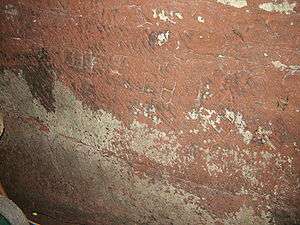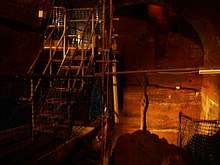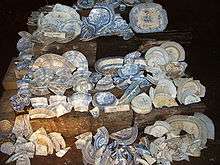Williamson Tunnels
Coordinates: 53°24′13″N 2°57′19″W / 53.403744°N 2.95525°W

The Williamson Tunnels are a series of large subterranean excavations in the Edge Hill area of Liverpool, England, which were created under the direction of tobacco merchant, landowner and philanthropist Joseph Williamson between 1810 and 1840. Although popularly described as "tunnels", the majority comprise brick or stone vaulting over excavations in the underlying sandstone. The purpose of the works remains unclear and quarrying, a philanthropic desire to provide employment, and Williamson's own eccentric interests have all been suggested.
They remained derelict, filled with rubble and refuse, until archaeological investigations were carried out in 1995. Since then further excavations have been carried out and part of the labyrinth of tunnels has been opened to the public as a heritage centre.
History
In 1805 Joseph Williamson acquired an area of land in Mason Street, Edge Hill, Liverpool, which was then a largely undeveloped outcrop of sandstone with a scattering of scars from small-scale quarrying. The land was held under a lease from the West Derby Waste Commissioners, who retained rights to the minerals under it. He started to build houses on the site.
According to the account of a 19th century Liverpool antiquarian, James Stonehouse, these houses were eccentric in design and "of the strangest description" without any rational plans. The ground behind the houses dropped sharply and in order to provide large gardens Williamson built arched terraces over which the gardens could be extended. When these were complete he continued to employ his workmen: according to Stonehouse this was sometimes to carry out apparently pointless tasks, such as moving rubble from one place to another, then back again.[1] Williamson took on many more labourers, recruiting from among the poor and needy of the area, including soldiers left unemployed at the end of the Napoleonic War. The many buildings erected by Williamson included a large house in Mason Street occupied by himself and his wife.[2]
Williamson's major project was to excavate an extensive series of brick-arched tunnels in various directions and depths within the sandstone to the limits of, and possibly beyond, the land owned by him. Stonehouse, who traversed parts of the tunnels in 1845, described the excavations as a labyrinth of "vaulted passages [...] pits deep, and yawning chasms",[3] including a "fearful opening" beneath Grinfield Street with two "complete four-roomed houses" in the side of it connected by a spiral passage.[4] This apparent tunnel-building activity continued until Williamson's death in 1840.[5] In August 1867 the Liverpool Porcupine described the tunnels as being "a great nuisance" because drains ran straight into them, in one place creating a cess pool full of offensive water 15 feet (5 m) deep, and they were being used for dumping refuse,[6] including down chutes built into the buildings above for the purpose. In the later 19th century the Corporation of Liverpool began backfilling the tunnels with rubble and other waste from building demolition, a process that sporadically continued into the 20th century. Little information about the excavations had been recorded and nearly all knowledge of them, and of Williamson's life, was derived from the writing of James Stonehouse. His account was not published at the time, but was referenced in his later works and was finally reprinted in full by Charles Hand as part of a 1916 article, "Joseph Williamson, the King of Edge Hill", published in the Transactions of the Lancashire and Cheshire Historical Society.
Investigations and archaeology
In 1881, the North Staffordshire Institute of Mining and Mechanical Engineers conducted a field trip to Liverpool during which they surveyed some of the surviving excavations, producing a plan and dog-leg section of the main parts of the site.[7]
In the early 20th century soldiers from the West Lancashire Territorial Forces Association explored the tunnels. Their drill hall in Mason Street stood on top of one of the tunnels. In 1907 the Association produced a map of the tunnels, which was incomplete because many of them were filled with rubble. The map also showed the course of the London and North Western Railway cutting between Edge Hill and Lime Street stations which ran through the area of the Williamson tunnels.[8] In 1995 a geology student from Liverpool University carried out a micro-gravity survey of the site. Some of his findings were ambiguous because of the rubble filling the tunnels and not all of his findings corresponded with those of the Forces Association. Later that year a professional firm, Parkman, carried out a survey on behalf of the Joseph Williamson Society.[9] Since then further investigations and excavations have been carried out.
The tunnels

The tunnels are in an area to the east of the Liverpool Metropolitan Cathedral in a rectangle bordered by Mason Street, Grinfield Street, Smithdown Lane and Paddington. Their full extent is not known and many of them are still blocked by rubble. They vary in size from the "banqueting hall", which is about 70 feet (21 m) long, between 20 feet (6 m) and 25 feet (8 m) wide and 20 feet (6 m) high, while the smaller tunnels are 4 feet (1 m) wide and 6 feet (2 m) high.[10][11] Still larger excavations, such as the vaulted "Great Tunnel" seen by James Stonehouse and Charles Hand[12] and noted on the Army surveys, have yet to be located.
Purpose of the tunnels
The reasons for building the tunnels have been widely discussed. According to Stonehouse, Williamson was secretive about his motives, leading to a great deal of speculative local folklore. On hearing that Stonehouse planned to publish his research on Williamson's excavations, Williamson's friend the artist Cornelius Henderson threatened to sue Stonehouse both for libel and trespass, leading to the paper's suppression for some years.[13]
The most usual story is that they were a philanthropic endeavour: Williamson's own explanation was reputed to be that his workers "all received a weekly wage and were thus enabled to enjoy the blessing of charity without the attendant curse of stifled self respect", his prime motive being "the employment of the poor".[14] Another suggestion was that he was a member of an extremist religious sect fearing that the end of the world was near and that the tunnels were built to provide refuge for himself and his friends:[15] however there is no evidence for this interpretation, which originated with a casual suggestion made on a television programme, and Williamson was a practising member of the Church of England.[16] Stonehouse and Hand both felt the excavations were simply the largely purposeless folly of an eccentric man: however while Stonehouse called the works "stupendously useless", Hand concluded that Williamson's philanthropic purpose was a noble one and felt he "should have been both pleased and proud to have known him".[17] Many of Williamson's workers were said to have later found employment in railway construction with the skills they had learned.
More recent research by academics at Edge Hill University has concluded that the "tunnels" were in fact largely an effort by Williamson to restore ground levels after quarrying.[18] Most of the excavations are directly within a band of high-quality sandstone, and show clear signs of having been carried out using established quarrying techniques designed to produce pieces of stone suitable for building use:[19] in addition, the cross-sections of the works produced by the 1881 survey reveal a typical stone quarry profile.[7] The apparently aimless nature of the excavations was likely a reflection of the work following the best "seam" of stone, avoiding imperfections and master joints.[20] The tunnels had, therefore, originally been unregulated "slot quarries" for sandstone, used for prestige buildings in the rapidly-expanding Liverpool of the Georgian era, and by subsequently vaulting them over Williamson was able to restore ground levels, facilitating his extensive housing developments on the site.[18] While during Williamson's lifetime it was locally rumoured that he was earning large sums from quarrying, Williamson had apparently claimed that he made little money from the stone extraction and used it largely within his own properties.[20] It seems possible that his secrecy was at least partly driven by a need to conceal his avoidance of both large amounts of income tax and mineral rights duties due to the West Derby Waste Commission from the sale of sandstone.[20] Knowledge of the latter dealings may have been the reason behind Henderson's threat to sue James Stonehouse.[20] Despite retiring from the tobacco trade in 1818, Williamson left an estate valued at £40,000 - the equivalent of around £40 million in 2013 - and it appears that a large proportion of this income must have come from his excavations and subsequent property development.[21]
The Joseph Williamson Society and Heritage centre

The Joseph Williamson Society was founded in 1989. It was incorporated as a private limited company in 1996 and acquired charitable status in 1997. Its aim is to promote interest in the life and philanthropic achievements of Joseph Williamson and takes the form of talks, tours, publications and educational visits.[22] In autumn 2002, after much excavation, removal of rubble and renovation, one of the three sections of the site, the Stable Yard section, was opened to the public as the Williamson Tunnels Heritage Centre under the trusteeship of the Joseph Williamson Society.[23] Visitors are taken on a guided tour which includes the south tunnel and the double tunnel and various artefacts are on view including some of the items which have been uncovered in the excavations.[24] A programme of events and entertainments is organised on the site.[25][26] The entry to the heritage centre was formerly part of the Lord Mayor's Stable Yard which closed in 1993.[27] The stable became the home for a horse again when Pop arrived in 2003.[28]
The Friends of Williamson's Tunnels (FoWT)
The Friends of Williamson's Tunnels (FoWT) were formed in 1996 and are a group of enthusiasts distinct from the Heritage Centre whose aim 'To advance the education of the general public in all matters relating to Joseph Williamson in particular to preserve... the works and any associated structures either above or below ground that can be accessed from the tunnel entrance at Williamson Student village, No 1 Paddington, Edge Hill'. It received charitable status in 2001.[29] They do not directly fund the Williamson Tunnels Heritage Centre, and were referenced on ITV news on 6 April 2018.[30]
References
Notes
- ↑ Stonehouse, in Hand, C. R. (1916), 14
- ↑ Hand, C. R. ( 1928), 88. In the 20th century this house was numbered 44.
- ↑ Stonehouse, in Hand, C. R. (1916), 6
- ↑ Stonehouse, in Hand, C. R. (1916), 7
- ↑ Murden, Jon, 'Williamson, Joseph (1769-1840)', Oxford Dictionary of National Biography, Oxford University Press, online edn, October 2006 , accessed 30 July 2008.
- ↑ Moore 1998, p. 80.
- 1 2 Lucas, Bridson and Jones (2014) "Williamson Tunnels, Edge Hill, Liverpool: an example of Georgian and early Victorian quarry restoration" in Hunger, Brown and Lucas (eds) Proceedings of the 17th Extractive Industry Geology Conference, EIG, p.11
- ↑ Moore 1998, pp. 79–80.
- ↑ Moore 1998, p. 81.
- ↑ FAQ, Friends of Williamson's Tunnels, retrieved 2008-08-04
- ↑ Virtual Tour, Friends of Williamson's Tunnels, retrieved 2008-08-04
- ↑ Hand, C. R. (1927), 89
- ↑ Hand, C. R. (1916), 3
- ↑ Quoted in Whittington-Egan 1985, p. 9.
- ↑ The Story, Friends of Williamson's Tunnels, archived from the original on 31 August 2009, retrieved 31 July 2008
- ↑ The lost tunnels buried deep beneath the UK, BBC, 03-09-15
- ↑ Hand, C. R. (1929) 101-102
- 1 2 Speed, "Williamson Tunnels – are they really quarries?", Edge Hill University, 6-08-12
- ↑ Lucas, Bridson and Jones (2014) "Williamson Tunnels, Edge Hill, Liverpool: an example of Georgian and early Victorian quarry restoration" in Hunger, Brown and Lucas (eds) Proceedings of the 17th Extractive Industry Geology Conference, EIG, p.13
- 1 2 3 4 Lucas, Bridson and Jones (2014) p.15
- ↑ Lucas, Bridson and Jones (2014) p.22
- ↑ About the Centre, The Joseph Williamson Society, retrieved 2008-08-04
- ↑ About FoWT, Friends of Williamson's Tunnels, retrieved 2008-08-04
- ↑ Come and see the Tunnels!, Friends of Williamson's Tunnels, retrieved 2008-08-04
- ↑ Latest News, The Joseph Williamson Society, retrieved 2008-08-05
- ↑ Calendar of Events, The Joseph Williamson Society, retrieved 2008-08-05
- ↑ Clark, Edward, 'The Cart Horse and the Quay', Countryside Publications
- ↑ New arrival at Stables, Friends of Williamson's Tunnels, 2003-10-29, retrieved 2008-08-05
- ↑ Extract from the Central Register of Charities maintained by the Charity Commission for England and Wales, Charity Commission of England and Wales, retrieved 2008-08-06
- ↑ Williamson Tunnels Heritage Centre Publicity Leaflet, Williamson Tunnels Heritage Centre, 2009 (Leaflet)
Bibliography
Further reading
- Clensy, David (2006), The Mole of Edge Hill, ISBN 1-4116-1792-4
- Stonehouse, James (1863), Recollections of Old Liverpool, Liverpool: J. F. Hughes
- Stonehouse, James (1869), The Streets of Liverpool, Liverpool: Edward Howell
- Hand, Charles R. (1917), Joseph Williamson: 'The King of Edge Hill' (PDF), Transactions of the Historic Society of Lancashire and Cheshire for the Year 1916, 68, Liverpool: Historic Society of Lancashire and Cheshire, pp. 1–23, retrieved September 6, 2015
- Hand, Charles R. (1928), Joseph Williamson, 'The King of Edge Hill' II. (PDF), Transactions of the Historic Society of Lancashire and Cheshire for the Year 1927, 79, Liverpool: Historic Society of Lancashire and Cheshire, pp. 86–111, retrieved September 6, 2015
External links
| Wikimedia Commons has media related to Williamson Tunnels. |